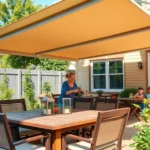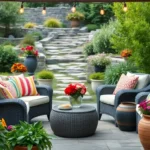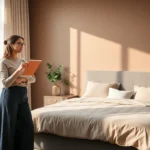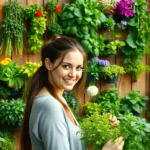We’ve all stared at our bookshelves wondering how to transform them from cluttered chaos into Instagram-worthy displays. Bookshelf styling isn’t just about organizing books – it’s about creating visual stories that reflect your personality while maximizing both function and beauty.
The secret lies in understanding that great bookshelf styling combines strategic placement with thoughtful curation. We’re talking about mixing books with decorative objects, playing with heights and textures, and creating breathing room that lets each element shine. Whether you’re working with built-ins, floating shelves, or a standalone bookcase, the right approach can turn any shelf into a stunning focal point.
Ready to elevate your space? We’ll walk you through proven techniques that interior designers use to create magazine-worthy bookshelves. From the rule of thirds to color coordination tricks, you’ll discover how small changes can make a dramatic impact on your room’s overall aesthetic.
Color-Coordinate Your Books for Visual Impact
Color coordination transforms chaotic bookshelves into organized masterpieces that catch the eye instantly. We’ll show you three powerful techniques that interior designers use to create stunning visual displays.
Group Books by Color Families
Organizing books by similar hues creates cohesive sections that feel intentional and polished. We recommend starting with your largest color groups like blues, greens, or earth tones to establish visual weight across your shelves. Sort books into warm families such as reds, oranges, and yellows versus cool families including blues, purples, and greens.
Place darker shades at the bottom of each color family to anchor the display. This technique mimics nature’s color distribution and creates stability in your arrangement. Lighter tones naturally flow upward, drawing the eye in a pleasing vertical movement.
Mix different book sizes within each color group to add visual texture. Combine tall hardcovers with shorter paperbacks and medium-sized novels to prevent monotony. This variation maintains the color story while creating ever-changing silhouettes that keep viewers engaged.
Create Rainbow Arrangements
Arranging books in ROYGBIV order produces striking displays that become conversation starters. We’ve seen this technique transform entire walls into artistic focal points that rival expensive artwork. Start with red books on the left and progress through orange, yellow, green, blue, indigo, and violet.
Dedicate one shelf or section to your rainbow arrangement for maximum impact. Full rainbow displays work best when they span 3-4 feet horizontally, giving each color adequate representation. Shorter arrangements often look incomplete and fail to achieve the desired wow factor.
Fill gaps between colors with neutral-toned books or decorative objects. White, black, or cream-colored books serve as natural transitions between bold hues. Small plants, candles, or bookends in complementary colors enhance the rainbow effect without disrupting the flow.
Use Monochromatic Schemes for Sophistication
Single-color arrangements create elegant, museum-quality displays that exude refined taste. We particularly love all-white book collections paired with brass or gold accents for timeless sophistication. Black books with silver accessories produce dramatic, contemporary looks that anchor modern spaces.
Vary textures and finishes within your chosen color palette to prevent flatness. Combine matte paperbacks with glossy dust jackets and leather-bound volumes in your selected hue. Different materials reflect light uniquely, adding depth to monochromatic displays.
Incorporate books with subtle color variations to maintain visual interest. Cream, ivory, and off-white books work beautifully together in white arrangements. Navy, royal blue, and powder blue create sophisticated blue schemes without breaking the monochromatic rule.
Mix Books with Decorative Objects
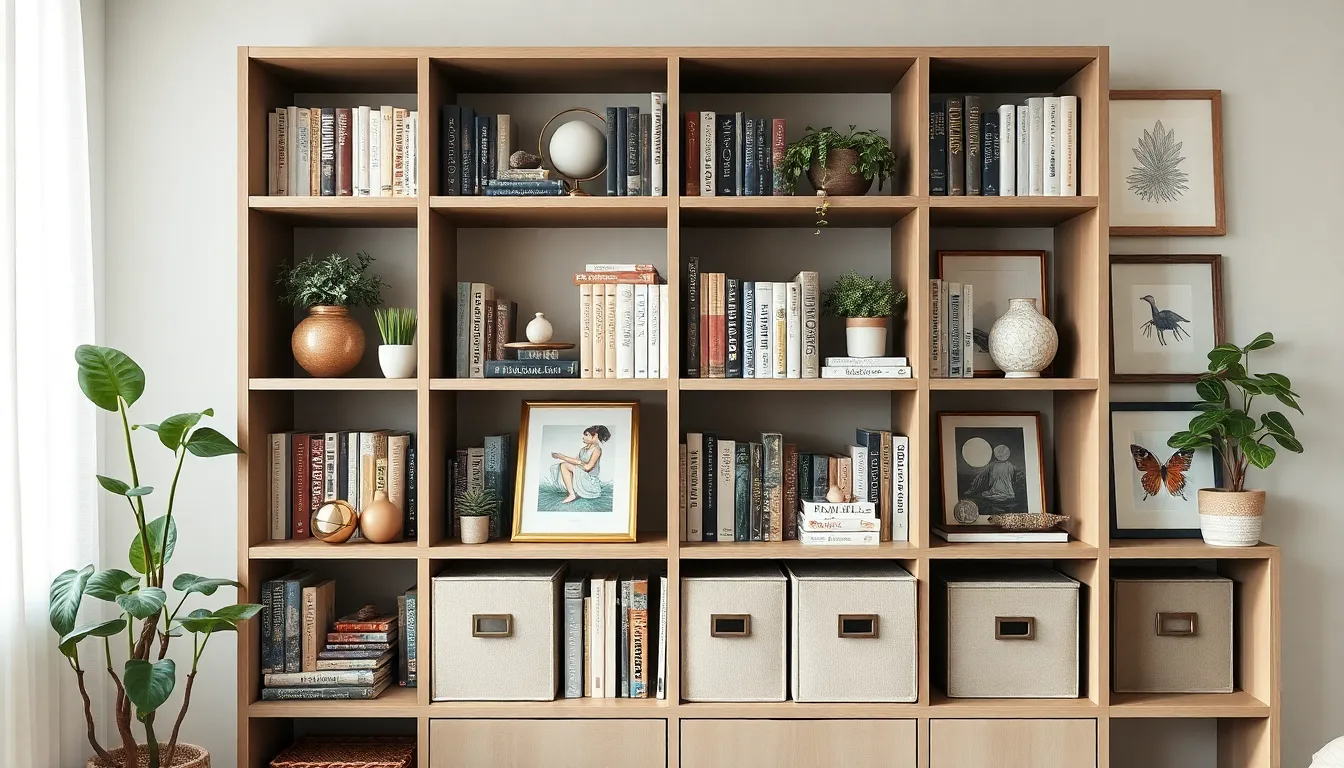
Creating visual balance through strategic placement of books and decorative elements transforms any bookshelf into a curated focal point. We recommend stacking books both vertically and horizontally to establish structure while providing platforms for displaying meaningful objects.
Incorporate Plants and Greenery
Adding small houseplants brings life and natural texture to your bookshelf arrangement. Plants can be nestled between book stacks or placed on horizontal surfaces to create organic contrast against printed spines. We suggest selecting low maintenance varieties like pothos, snake plants, or small succulents that thrive in indoor lighting conditions. Fresh greenery softens the linear appearance of books while improving air quality in your space. Position trailing plants on higher shelves to add cascading movement, or use upright plants to create height variation between different sections.
Add Personal Collectibles and Artwork
Displaying personal collectibles transforms your bookshelf from storage into storytelling space. Travel souvenirs, small sculptures, and family heirlooms create conversation starters while reflecting your unique personality. We recommend leaning framed artwork or photographs against the back wall of shelves to add color and depth. Layer these pieces in front of or behind books to establish visual layers that draw the eye inward. Mix different sized frames and objects to avoid monotony, ensuring each piece has breathing room to be appreciated individually while contributing to the overall composition.
Include Functional Items Like Baskets and Boxes
Incorporating baskets, boxes, and decorative trays adds practical storage while maintaining aesthetic appeal. These functional pieces work particularly well on lower or wider shelves where they can contain items like remotes, create supplies, or paperwork. We choose neutral colored storage answers in natural materials like wicker, wood, or linen to complement rather than compete with other decorative elements. These containers help maintain a tidy appearance while their varied textures enhance the overall design without overwhelming the space.
Vary Book Placement and Positioning

Ever-changing book arrangement transforms ordinary shelves into curated displays that capture attention. We’ll explore three essential positioning techniques that professional designers use to create visual interest and sophisticated balance.
Stack Books Horizontally and Vertically
Horizontal stacking adds visual interest and provides space for decorative items while creating natural platforms throughout your display. We recommend placing 2-3 books flat to form stable surfaces for bowls, sculptures, or small plants. This technique breaks up the monotony of vertical spines and creates opportunities for layered styling.
Vertical stacking allows for maximizing shelf storage and creating orderly lines that maintain organization while looking intentional. We mix both orientations within the same shelf section to establish rhythm and prevent rigid uniformity. Placing a stacked set of books covered by an object enhances texture and creates layered depth that draws the eye inward.
Create Asymmetrical Groupings
Asymmetrical arrangements avoid overly uniform displays and instead embrace the collected, curated appearance that makes shelves feel personal. We recommend pairing two or three books of varying thickness with a small plant or sculpture, arranging them off-center for a relaxed, artistic effect.
Mixing objects of different heights, sizes, and shapes prevents your shelves from looking too structured or predictable. We group items in odd numbers and vary their placement across each shelf level. This approach helps draw the eye across the shelf and makes displays feel more personalized rather than staged.
Leave Strategic White Space Between Items
Negative space allows each object or book to stand out and prevents visual overload that can make shelves appear cluttered. We ensure gaps between groupings for breathing room, which is essential for maintaining a stylish and uncluttered look.
Minimalist approaches pair neutral books with single decorative pieces and use strategic spacing to create breathing room. We apply this technique by leaving at least 2-3 inches between distinct groupings, allowing each collection of items to register as its own vignette. This design strategy makes even small collections appear artfully arranged rather than cramped together.
Create Themed Sections and Zones

Themed sections transform ordinary bookshelves into purposeful displays that guide visitors through your collection. We’ll explore proven strategies for organizing your books into meaningful zones that enhance both functionality and visual appeal.
Designate Areas by Genre or Subject
Genre organization creates the foundation for a well-structured bookshelf that’s both beautiful and practical. We recommend dedicating exact sections to fiction, non-fiction, and children’s books to establish clear visual boundaries that make browsing effortless for visitors[5].
Color coding offers a striking alternative approach that arranges books by hue rather than subject matter. This technique creates a visually appealing rainbow effect that works exceptionally well in minimalist settings where clean lines and color gradients take center stage[3].
Niche focus allows you to create specialized areas for exact interests like cookbooks, travel guides, or art history books. These focused zones help visitors quickly locate materials that match their interests while creating conversation starters about your personal passions[5].
Establish Reading Nooks with Coordinated Accessories
Cozy ambiance forms the heart of any successful reading nook through the strategic placement of plush seating and soft lighting. We suggest positioning comfortable chairs or cushions near your themed sections and adding coordinated accessories like throw pillows and blankets to encourage longer reading sessions[5].
Personal touches elevate reading spaces beyond mere functionality by incorporating meaningful decorations and family photos. These elements create emotional connections that make visitors feel welcome while reflecting your unique personality and interests throughout the space.
Lighting coordination ensures that each reading nook offers adequate illumination for comfortable reading. Position table lamps or floor lamps near seating areas and coordinate their style with your bookshelf’s overall aesthetic to maintain visual harmony.
Build Seasonal Display Corners
Seasonal themes breathe new life into your bookshelf displays by reflecting the current time of year through carefully chosen decorative elements. We recommend creating dedicated corners that showcase winter themes with snow globes or summer vibes with beach-inspired decor[3].
Rotating displays keep your bookshelf captivating throughout the year by regularly updating decorative elements and featured books. This practice maintains visual interest and gives you opportunities to highlight new acquisitions, seasonal reads, or themed artwork that matches the current season[5].
Seasonal book selection complements your decorative themes by featuring titles that align with the time of year. Display holiday cookbooks during winter months, gardening guides in spring, or travel memoirs during summer to create cohesive seasonal experiences for visitors.
Incorporate Lighting Elements
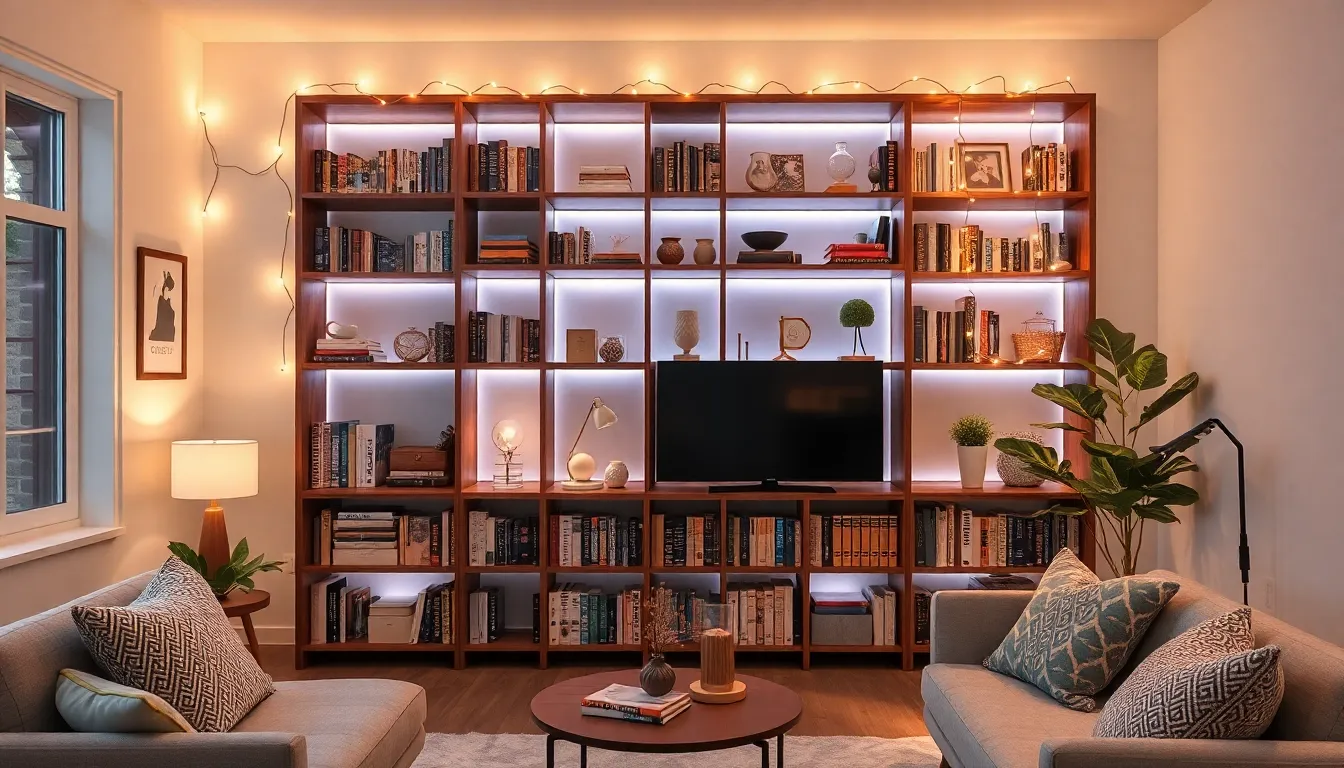
Strategic lighting transforms our bookshelves from simple storage into captivating focal points that illuminate both our books and decorative elements.
Add LED Strip Lights Behind Shelves
LED strip lights create a modern and sleek appearance when placed behind bookshelf sections. We can easily install these versatile lighting answers to highlight decorative items like vases, picture frames, and book collections with a clean glow.
Installation requires minimal technical skills since most LED strips come with adhesive backing. We simply peel and stick them along the back edges of our shelves for instant illumination.
Modern LED technology offers dimming capabilities and color temperature control. We can adjust the brightness to complement our room’s ambiance while maintaining energy efficiency throughout daily use.
Include Small Table Lamps or Spotlights
Small table lamps provide warm, focused lighting that creates inviting focal points on our bookshelf displays. We can position these compact fixtures directly on shelves to highlight exact areas like reading nooks or prized book collections.
Spotlights offer directional control that lets us illuminate particular objects with precision. We can angle these adjustable fixtures toward artwork, sculptural pieces, or leather bound volumes to create dramatic visual impact.
Task lighting from lamps and spotlights serves dual purposes in our styling approach. We gain functional illumination for reading while adding warm atmospheric elements that make our spaces feel more welcoming.
Use Fairy Lights for Ambient Glow
Fairy lights wrapped around shelf edges create a whimsical and cozy atmosphere in our bookshelf arrangements. We can weave these delicate strands behind books and decorative objects to establish soft background illumination.
Battery operated fairy lights offer placement flexibility without requiring nearby electrical outlets. We can position them anywhere on our shelves while maintaining clean lines and avoiding visible cords.
Ambient lighting from fairy strands works especially well in bedrooms and reading areas where we want relaxing environments. We can create layered lighting effects by combining fairy lights with other illumination sources for depth and visual interest.
Play with Height and Texture Variations
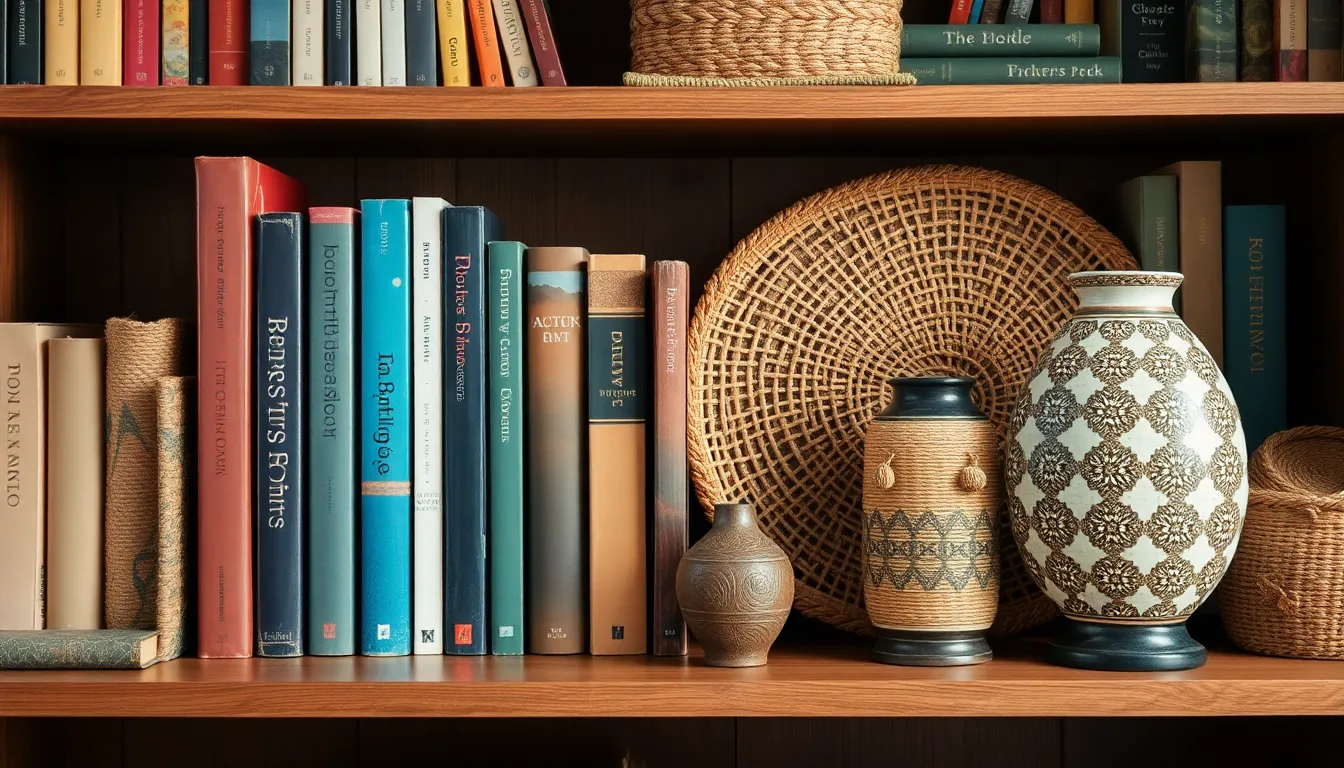
Creating ever-changing bookshelf displays requires strategic layering of items with different heights and textures. We’ll transform flat, monotonous shelves into captivating focal points through intentional placement techniques.
Use Bookends and Risers for Different Levels
Bookends serve dual purposes by keeping our books organized while providing elevated surfaces for decorative items. We can select bookends in materials like marble, wood, or metal to complement our existing decor and add visual weight to shelf arrangements.
Risers elevate smaller objects and create multiple viewing levels that draw the eye upward through our displays. We position risers strategically to showcase special items like small sculptures, candles, or framed photos that might otherwise get lost among larger books.
Staggered heights prevent visual monotony and create natural flow patterns across our shelves. We alternate between tall books, medium decorative objects, and lower items to establish rhythm and movement that keeps viewers engaged.
Mix Hardcover and Paperback Books
Combining hardcover and paperback books adds immediate texture variation through different spine thicknesses and materials. We group these mixed formats together to create organic clusters that feel more collected than perfectly uniform arrangements.
Varying book thicknesses creates natural spacing between items and prevents our shelves from looking like rigid library stacks. We intentionally place thicker art books next to slimmer paperbacks to establish visual breathing room.
Different binding styles introduce subtle texture contrasts through glossy dust jackets, matte paperback covers, and cloth hardcover spines. We leverage these material differences to create tactile interest that invites closer inspection.
Add Textured Objects Like Woven Baskets
Woven baskets introduce organic texture that softens the angular lines of books and creates warmth in our displays. We select baskets in natural materials like rattan, jute, or seagrass to add earthy elements that balance hard surfaces.
Textured objects serve functional purposes while improving visual appeal through their unique surfaces and materials. We incorporate items like vintage vases with raised patterns, carved wooden bowls, or ceramic pieces with interesting glazes.
Natural materials create contrast against smooth book spines and add dimensional interest through their varied surfaces. We position textured elements strategically to break up book groupings and create focal points that anchor our arrangements.
Hide Clutter with Stylish Storage Solutions
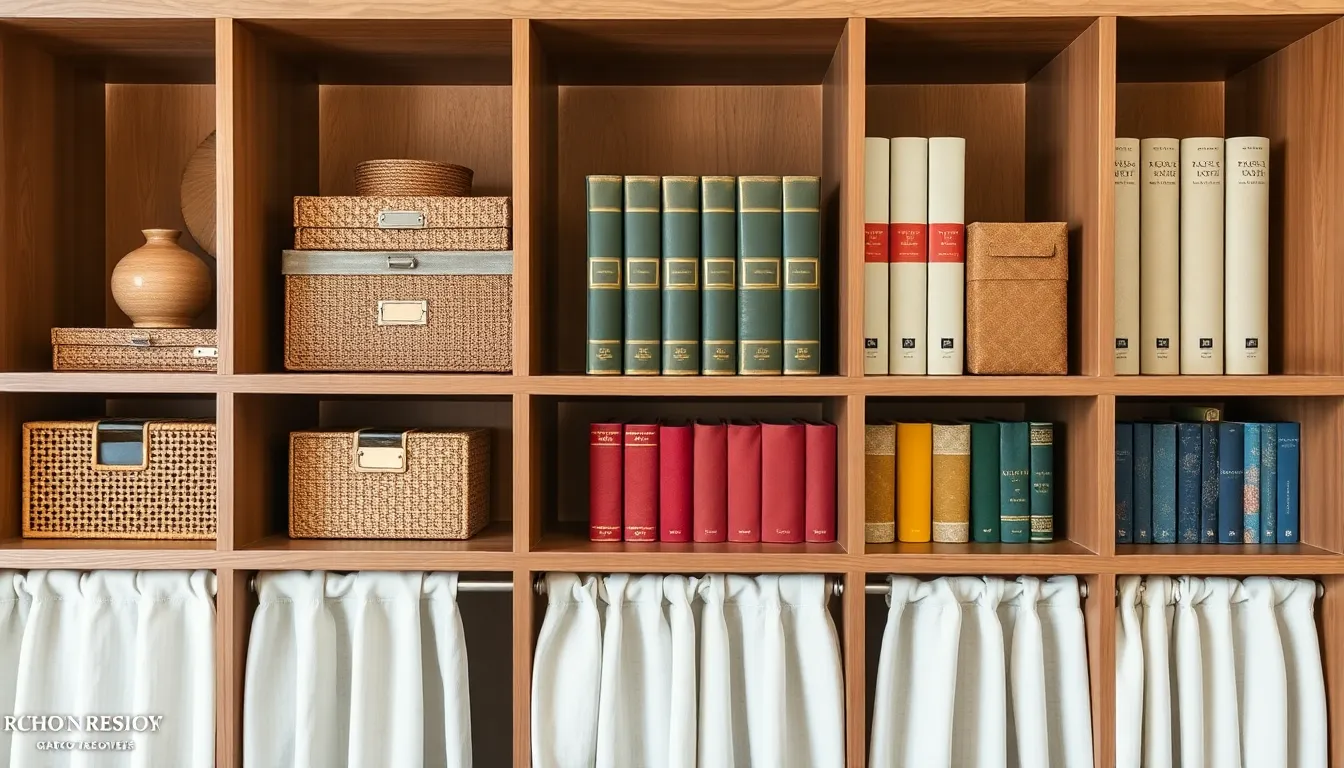
We can maintain our beautifully styled bookshelves while keeping everyday items organized and out of sight. Strategic storage answers allow us to preserve the aesthetic appeal of our displays without sacrificing functionality.
Use Decorative Boxes and Containers
Decorative boxes serve as perfect hiding spots for clutter while adding visual interest to our shelves. We recommend choosing boxes in materials like woven rattan, linen-covered cardboard, or sleek metal finishes that complement our existing decor. These containers can store everything from cables and chargers to small office supplies and personal documents.
Varying box sizes creates ever-changing visual arrangements on our shelves. We suggest mixing small jewelry boxes with medium storage containers and larger document holders to achieve balanced proportions. Labels on the inside or bottom of boxes help us remember contents without disrupting the clean exterior appearance.
Coordinating container colors with our bookshelf’s color scheme maintains visual harmony. We can select neutral tones like cream, gray, or natural wood finishes for versatile appeal, or choose bold colors that echo our book spines for a more cohesive look. Textured containers like bamboo baskets or fabric bins add warmth while concealing items we use frequently.
Incorporate Fabric-Covered Binders
Fabric-covered binders transform mundane storage into stylish shelf accessories. We can wrap standard three-ring binders with coordinating fabrics, decorative paper, or contact paper to create custom storage that blends seamlessly with our books. These binders work perfectly for organizing important documents, warranties, or photo collections.
Creating uniform spine labels ensures our fabric binders look intentional rather than makeshift. We recommend using consistent fonts and colors for labels, positioning them at the same height on each binder spine. This attention to detail makes storage binders appear as carefully curated design elements rather than hidden necessities.
Grouping fabric binders by color or pattern creates striking visual blocks on our shelves. We can arrange them alongside books of similar hues or use them as bookends for shorter volumes. The soft texture of fabric adds tactile interest while maintaining the sophisticated appearance of our bookshelf displays.
Add Curtains or Sliding Panels for Hidden Storage
Installing curtains behind certain shelf sections creates concealed storage areas for items we need but don’t want displayed. We can mount slim curtain rods inside bookshelf frames and hang fabric panels that match our room’s decor. This solution works particularly well for lower shelves where we might store cleaning supplies or seasonal items.
Sliding panels offer a more permanent solution for hiding clutter while maintaining easy access. We recommend lightweight materials like frosted acrylic or fabric-covered boards that slide along tracks mounted inside our shelves. These panels can conceal entire sections when closed but slide away completely when we need to access stored items.
Choosing panel materials that complement our overall design keeps hidden storage areas from looking like afterthoughts. We can select translucent materials that hint at contents without fully revealing them, or opaque panels in colors that coordinate with our shelf styling. The key is ensuring these concealment answers enhance rather than detract from our bookshelf’s visual appeal.
Conclusion
We’ve equipped you with the essential tools to transform your bookshelves from simple storage into stunning design statements. From mastering color coordination and strategic placement to incorporating lighting and seasonal displays these techniques will help you create spaces that truly reflect your personality.
Remember that the best bookshelf styling comes from experimentation and personal touches. Don’t be afraid to mix textures vary heights and incorporate meaningful objects alongside your favorite reads. The key is finding the perfect balance between functionality and visual appeal.
Your bookshelves are waiting to become the focal point of your room. Start with one technique that resonates with you and gradually build upon it. With these designer-proven strategies you’ll create displays that not only organize your books beautifully but also tell your unique story through thoughtful curation.
Frequently Asked Questions
What is bookshelf styling and why is it important?
Bookshelf styling is the art of arranging books and decorative objects to create visually appealing displays that reflect your personal style. It goes beyond simple organization to transform bookshelves into stunning focal points that enhance your living space and showcase your personality.
How do I use color coordination to style my bookshelves?
Use three main techniques: group books by color families for cohesion, create rainbow arrangements in ROYGBIV order for vibrant displays, or employ monochromatic schemes with texture variations for sophistication. These color strategies help create visually striking and organized bookshelf arrangements.
What decorative objects should I mix with my books?
Incorporate small houseplants like pothos or succulents, personal collectibles, artwork, and functional items like decorative baskets or boxes. These elements add visual balance, texture, and personality while maintaining both aesthetic appeal and practical storage solutions.
How do I create visual interest with book placement?
Vary your book positioning by mixing horizontal and vertical stacking, creating asymmetrical groupings, and using different heights and sizes. Leave strategic white space between items to prevent clutter and allow each piece to stand out for a more artful arrangement.
What are themed sections and how do I create them?
Themed sections organize books by genre, subject, or season to enhance functionality and visual appeal. Create reading nooks with coordinated accessories, establish seasonal display corners with rotating elements, and group related books together to tell a cohesive story.
How can lighting enhance my bookshelf displays?
Use LED strip lights behind shelves for modern appeal, small table lamps or spotlights for focused illumination, and fairy lights for whimsical ambiance. Strategic lighting creates inviting atmospheres and highlights your carefully curated bookshelf arrangements.
What are some stylish storage solutions for bookshelves?
Use decorative boxes and containers to hide clutter, fabric-covered binders for document organization, and consider installing curtains or sliding panels for concealed storage. These solutions maintain aesthetic appeal while ensuring functionality and organization.
How do I create height and texture variations?
Use bookends and risers to create different levels, mix hardcover and paperback books for texture variety, and incorporate textured objects like woven baskets. These elements add visual flow and prevent monotonous arrangements while introducing warmth and organic elements.


